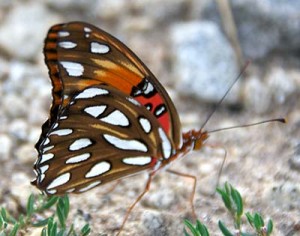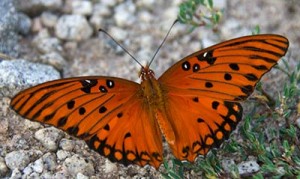Gulf Fritillaries are common butterflies in the American South, and they range southward through Central America to Argentina. We found this one on a gravel parking lot, where it was apparently sucking up some minerals from the stones. In the side view, the animal’s long proboscis can be seen probing the rocks. This striking creature is a Gulf Fritillary (Agraulis vanillae ). It is a member of the longwing group of butterflies, (subfamily Heliconiinae) of the Brushfoot family (Nymphalidae). Members of this family have very short front legs that are not usually visible in photographs. Only four feet can be seen in the photograph to the lower right. The brightly colored larvae feed on various species of Passionflower, including the Maypop (Passiflora incarnata).

Gulf Fritillary underwing
Chemicals in the plant make the caterpillar toxic, and most birds avoid eating it. However, some wasps are not deterred, and eagerly kill them to feet their own larvae. The “Gulf” in the common name comes from the fact that it migrates over the Gulf of Mexico. The Fritillary in the common name is somewhat of a misnomer, since it is not closely related to the true fritillaries, which are in another subfamily. Fritillary comes from the Latin for “chessboard” or “dice box”, reflecting the checkered color pattern of many members of the true fritillary family.

